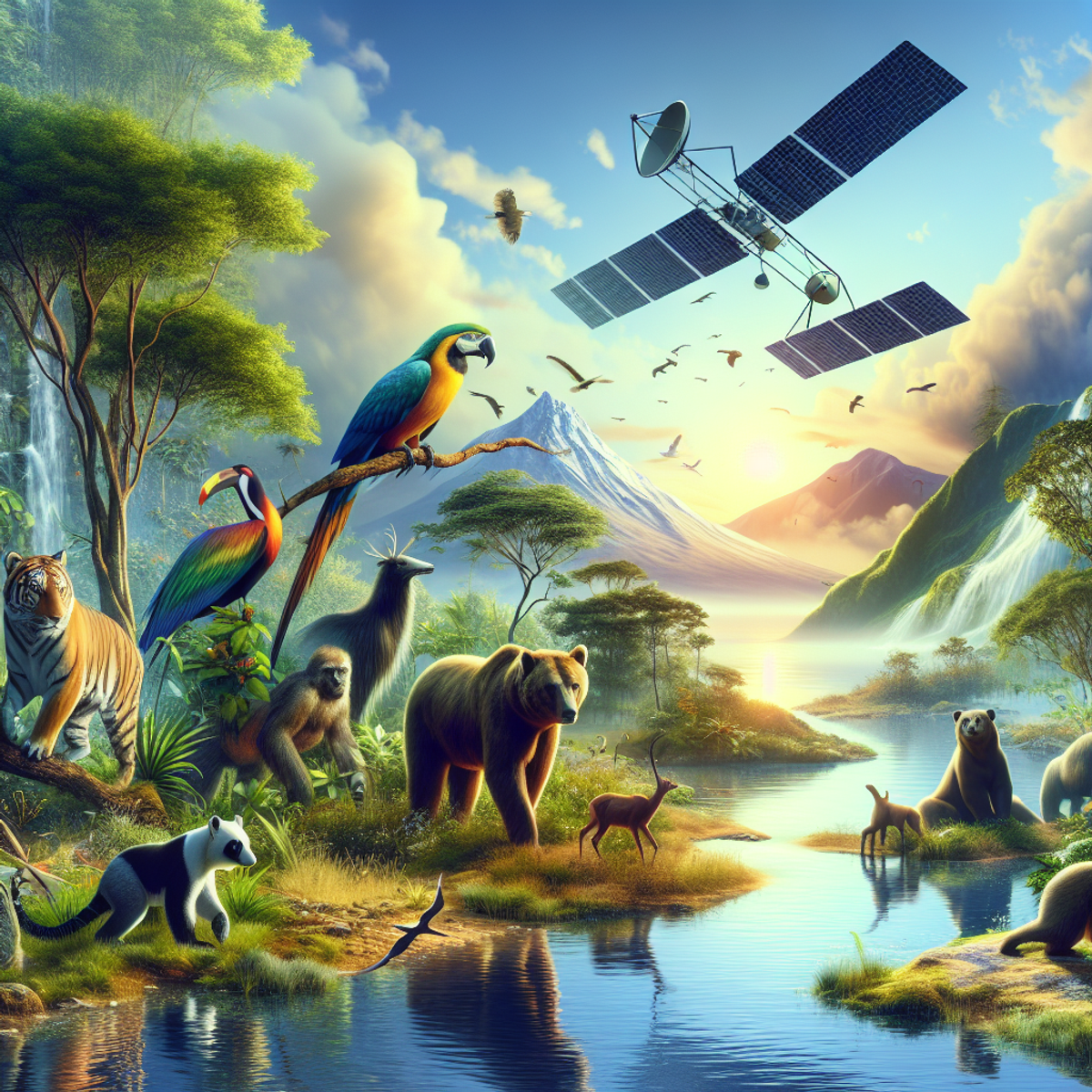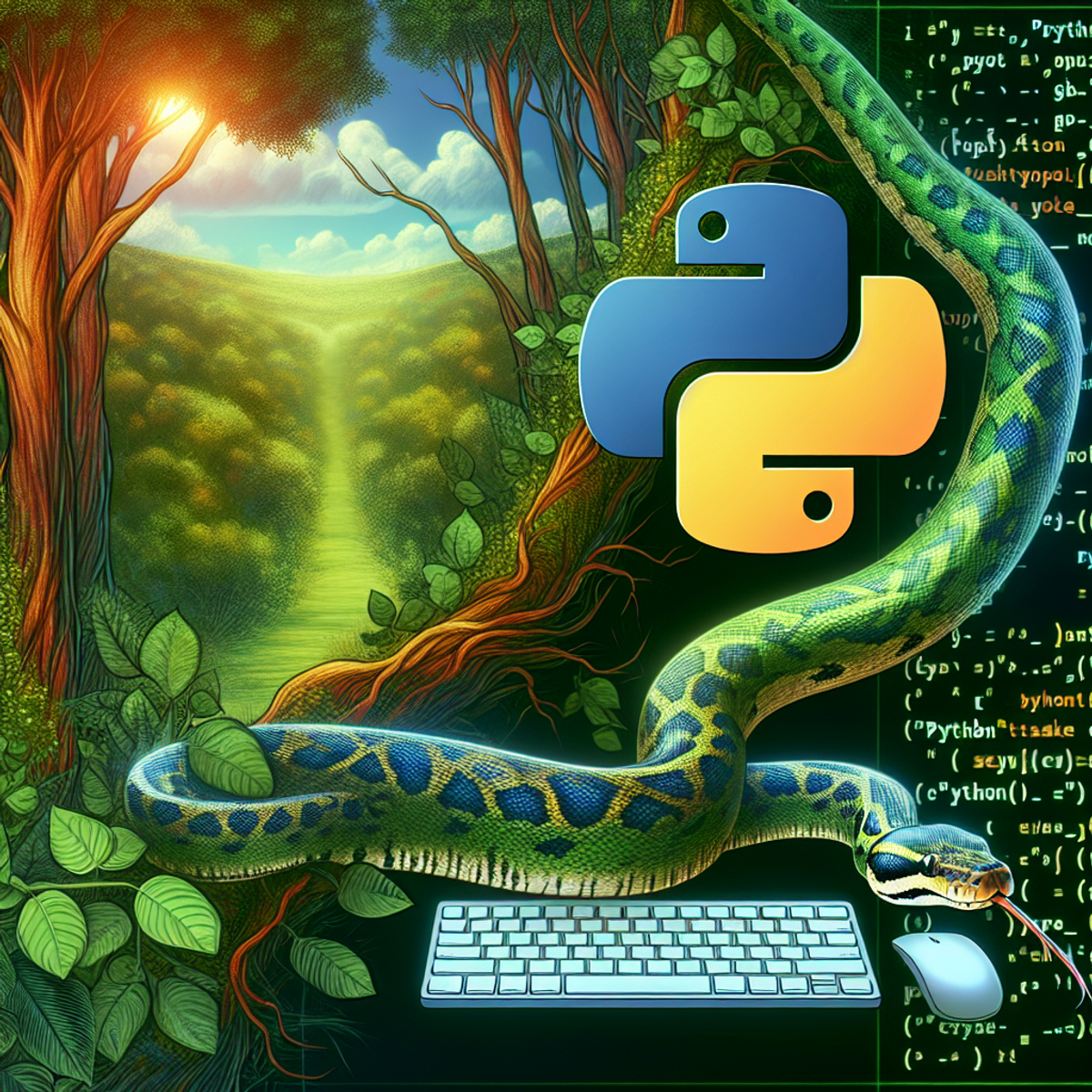Python and Wildlife Tracking: Conservation Technology

Python and Wildlife Tracking: Conservation Technology
Introduction
Wildlife tracking is essential for conservation efforts as it helps us understand animal behavior, migration patterns, and habitat preferences. This knowledge allows conservationists to make informed decisions and effectively manage wildlife populations.
Technology has played a significant role in improving wildlife tracking methods, making data collection faster and more accurate. From advanced tracking devices to aerial drones, these technological advancements have expanded our ability to monitor wildlife and protect different species.
Python, a versatile programming language, has become a valuable tool in implementing innovative solutions for wildlife monitoring. Its flexibility and extensive libraries make it perfect for handling large amounts of data, creating custom analysis tools, and integrating with various tracking technologies.
With Python, conservationists can:
- Streamline data analysis processes
- Develop specialized algorithms for pattern recognition in tracking data
- Create interactive visualizations to better understand animal movements and behaviors
This combination of technology and programming has brought significant changes to wildlife tracking, opening up new opportunities for conservation efforts worldwide.
In this article, we will explore how Python is driving innovation in wildlife tracking and conservation technology across various applications:
- Spatial monitoring software
- Advanced telemetry systems
- Aerial drones
- Acoustic sensors
- Geospatial insights
We will also discuss the specific ways Python is integrated into these technologies to improve data analysis, automate tasks, and promote collaboration among researchers and conservation organizations.
Through this exploration, we hope to emphasize the important role Python plays in advancing technology for wildlife tracking and conservation.
Python and Wildlife Tracking
Python has become a powerful tool for wildlife tracking and conservation efforts, allowing researchers and conservationists to create new solutions using its many capabilities. By using Python in wildlife tracking methods, the field has been transformed with more advanced techniques for analyzing data, creating visualizations, and building models. Here are some of the main ways Python is used in wildlife tracking:
1. Data Analysis and Visualization
- Python's extensive libraries like NumPy, Pandas, and Matplotlib make it easy to process and visualize data in wildlife tracking projects.
- With these libraries, researchers can study large amounts of data from tracking devices and sensor networks to learn more about how animals move, behave, and choose their habitats.
2. Customized Algorithms and Modules
- Python's flexibility allows for the creation of customized algorithms and modules that are specific to the needs of wildlife tracking.
- Conservationists use Python to develop complex systems for processing data and creating tools that work well in different research situations.
3. Collaborative Development Environment
- Python's open-source nature encourages collaboration among developers working on wildlife tracking solutions, leading to more sharing of knowledge and innovative ideas within the conservation community.
- Research teams can work together on projects based on Python, which helps improve wildlife monitoring technologies over time.
4. Integration with Tracking Devices
- Python can easily connect with various tracking devices and telemetry systems, making it simpler to collect and combine data.
- By using Python with these devices, conservationists can get real-time tracking information and analyze it immediately while working in the field.
5. Geospatial Modeling and Mapping
- Python's geospatial libraries (such as GeoPandas and Shapely) give conservationists the ability to make detailed models of habitats and create maps showing how animals move.
- These tools let researchers see the connections between wildlife populations and their environments, which helps make better decisions for conservation.
Python also finds application in several other domains of data science such as Natural Language Processing (NLP) and LIDAR data processing. This indicates the vast potential of Python as a versatile language in the broader field of scientific research.
Overall, Python plays a crucial role in bringing new ideas to wildlife tracking by providing a strong foundation for data analysis, algorithm creation, collaboration, device integration, and geospatial modeling. It continues to be used more and more in conservation technology as researchers discover new ways to solve complex problems in wildlife monitoring.
By fully embracing Python as a valuable tool in wildlife tracking efforts, conservationists can make significant progress in protecting species and managing ecosystems. The smooth combination of Python with state-of-the-art technologies increases the effectiveness of conservation work, leading to a better balance between humans and wildlife.
Conservation Technology
Conservation technology plays a crucial role in wildlife tracking efforts by providing innovative solutions to monitor and protect endangered species. With the advancement of technology, conservationists now have access to a wide range of tools and techniques that aid in data collection, analysis, and visualization. Python, being a versatile programming language, has emerged as a valuable tool for implementing these technologies and driving advancements in wildlife tracking.
Here are some key areas where conservation technology, powered by Python, is making a significant impact:
1. Spatial Monitoring with SMART Conservation Software
SMART Conservation Software is revolutionizing spatial monitoring by enabling conservationists to collect, analyze, and visualize data on wildlife populations and threats. Developed by the Wildlife Conservation Society (WCS) and the Zoological Society of London (ZSL), SMART provides a comprehensive platform for monitoring protected areas.
Python plays a crucial role in developing customized modules for data analysis in SMART software. It allows conservationists to harness the power of Python libraries such as NumPy, Pandas, and Matplotlib to process large datasets efficiently. These modules enable advanced statistical analyses, habitat modeling, and trend forecasting, providing valuable insights for effective conservation planning.
An example of successful application is the use of SMART software in endangered species conservation. By combining GPS tracking data with SMART's analytical capabilities, researchers can identify critical habitats and migration corridors for species like tigers or elephants. This information helps inform conservation strategies and ensure the protection of these vulnerable populations.
2. Advanced Telemetry Systems (ATS) Tracking Solutions
Technological advancements have significantly influenced the evolution of wildlife telemetry systems. Advanced Telemetry Systems (ATS) is at the forefront of developing cutting-edge tracking devices that provide accurate and real-time data on animal movements.
ATS offers a range of tracking solutions tailored to different species and research objectives. These devices utilize various technologies such as GPS, VHF radio, satellite transmitters, and accelerometers to collect data on animal behavior, migration patterns, and habitat utilization.
Python plays a role in analyzing the vast amount of data collected by ATS tracking devices. With Python, researchers can develop algorithms to process and interpret telemetry data, enabling them to gain insights into animal movements and behaviors. This information is crucial for understanding species dynamics, identifying threats, and designing effective conservation strategies.
Innovative use cases of ATS technology include studying animal behavior in challenging environments such as deep-sea habitats or dense rainforests. By combining ATS tracking devices with Python-powered data analysis, researchers can uncover hidden patterns and behaviors that were previously inaccessible.
3. Aerial Surveys with Python-Powered Wildlife Drones
Aerial surveys have become an invaluable tool in wildlife tracking, allowing researchers to cover vast areas quickly and efficiently. Python enables autonomous flight control and image processing in drone-based surveys, making it an integral part of wildlife conservation efforts.
Wildlife Drones, a leading provider of drone technology for conservation purposes, collaborates with researchers worldwide to protect migratory bird habitats. By using Python for flight control systems, researchers can program drones to conduct systematic surveys, capturing high-resolution imagery of bird populations and their habitats.
The captured images are then processed using Python libraries like OpenCV and TensorFlow for automated image recognition and species identification. This enables researchers to monitor population
SMART Conservation Software: Revolutionizing Spatial Monitoring
The SMART Conservation Software has been a game-changer in the field of wildlife tracking and conservation. This innovative tool has revolutionized spatial monitoring and data analysis, providing conservationists with valuable insights for protecting endangered species and their habitats.
Overview of SMART Conservation Software
SMART Conservation Software, also known as the Spatial Monitoring and Reporting Tool, is a powerful platform designed to support the effective management of wildlife populations. It offers a wide range of features, including:
- Spatial Monitoring: The software enables real-time monitoring of wildlife populations within their natural habitats, allowing conservationists to visualize animal movements and population dynamics.
- Data Analysis: SMART provides advanced analytical tools for processing large sets of tracking data, facilitating the identification of trends and patterns crucial for conservation efforts.
- Customization: Users can develop customized modules tailored to specific research needs, making it a versatile tool for addressing unique challenges in wildlife tracking.
Utilization of Python in SMART Software Development
Python plays a pivotal role in the development of customized modules and data analysis within the SMART Conservation Software. Its flexibility and extensive libraries make it an ideal programming language for enhancing the functionality of the software. Python enables developers to:
- Create Custom Modules: Conservationists can leverage Python to create specialized modules that cater to specific research requirements, thereby enhancing the adaptability of the software.
- Data Analysis: Python's data processing capabilities empower users to perform comprehensive analysis on tracking data, extracting meaningful insights vital for informed decision-making.
Case Study: Successful Application in Endangered Species Conservation
One notable example of SMART software's success is its application in the conservation of endangered species. By utilizing customized Python modules and advanced data analysis features, conservationists were able to:
- Monitor Endangered Species: The software facilitated precise monitoring of endangered species, enabling conservationists to track their movements and assess population trends.
- Inform Conservation Strategies: Through detailed data analysis, conservationists gained valuable insights into habitat usage and migration patterns, informing strategic initiatives aimed at protecting endangered species.
The successful utilization of SMART Conservation Software in this case underscores its significance as a tool for wildlife tracking and conservation efforts. By harnessing the power of Python and innovative technology, conservationists are empowered to make informed decisions that positively impact global biodiversity.
2. Advanced Telemetry Systems (ATS) and its Cutting-Edge Tracking Solutions
Advanced Telemetry Systems (ATS) is a leading provider of innovative wildlife tracking devices. With advancements in technology, ATS has played a crucial role in shaping the evolution of wildlife telemetry, enabling researchers to gather valuable data on animal behavior and movements. Let's explore the different types of advanced tracking devices offered by ATS and some innovative use cases.
GPS Collars
ATS offers GPS collars that provide real-time location data for animals. These collars are equipped with high-precision GPS receivers, allowing researchers to track the movements of animals with remarkable accuracy. The collected data can then be analyzed using Python-based software to gain insights into habitat use, migration patterns, and spatial behavior.
Satellite Tags
ATS also provides satellite tags that enable researchers to track animals over long distances, including marine species like whales and sea turtles. These tags transmit location data via satellite communication systems, allowing scientists to monitor the movements of animals across vast oceanic regions. Python programming can be used to process and visualize the data obtained from satellite tags, facilitating a better understanding of animal migrations and distribution.
Biologgers
Biologgers are miniature tracking devices that can be attached to animals to collect various types of data such as temperature, depth, acceleration, and even heart rate. ATS offers biologgers with built-in sensors that record these parameters at regular intervals. Python programming can be utilized to analyze the collected data and extract valuable insights into animal physiology and behavior.
In addition to these cutting-edge tracking devices, ATS has been involved in numerous innovative projects that have revolutionized wildlife research:
- Tracking Endangered Species: By using ATS GPS collars, researchers have successfully tracked endangered species such as tigers, rhinos, and orangutans. The precise location data provided by these collars helps conservationists understand movement patterns, identify critical habitats, and develop effective conservation strategies.
- Migration Studies: ATS tracking devices have been instrumental in studying the migratory patterns of birds and marine animals. For example, researchers have used satellite tags to track the migration routes of sea turtles, providing valuable information for conservation efforts aimed at protecting their nesting sites and feeding grounds.
- Behavioral Research: Advanced telemetry systems have facilitated groundbreaking research on animal behavior. By using biologgers equipped with sensors, scientists have gained insights into the diving patterns of marine mammals, the foraging behavior of seabirds, and the activity patterns of terrestrial animals. These findings contribute to our understanding of ecological interactions and help inform conservation management decisions.
The integration of Python programming with ATS tracking devices has further enhanced the potential for data analysis and visualization. Researchers can leverage Python libraries such as pandas, matplotlib, and seaborn to process large datasets, generate informative visualizations, and uncover hidden patterns in animal movement data.
Advanced Telemetry Systems (ATS) offers a range of cutting-edge tracking solutions that have revolutionized wildlife research. Through GPS collars, satellite tags, and biologgers, researchers can gather valuable data on animal behavior and movements. The integration of Python programming with these tracking devices enhances data analysis capabilities and enables researchers to gain meaningful insights into wildlife ecology. By harnessing the power of technology and Python, we can continue to advance our understanding of the natural world and work towards effective conservation strategies.
The Soaring Heights: Python-Powered Wildlife Drones for Aerial Surveys
Wildlife tracking has entered a new era with the integration of aerial drones into conservation projects. These unmanned aerial vehicles (UAVs) have revolutionized the way researchers gather data and monitor wildlife in remote or inaccessible areas. Python, a versatile programming language, plays a pivotal role in enabling the capabilities of wildlife drones for aerial surveys.
Significance of Aerial Drones in Expanding Wildlife Tracking Projects
- Remote Monitoring: Aerial drones provide an unprecedented ability to conduct wildlife surveys in challenging terrains such as dense forests, mountainous regions, and wetlands. This expanded reach allows conservationists to monitor elusive species and their habitats effectively.
- Reduced Disturbance: Traditional ground-based monitoring methods can disrupt natural behaviors and ecosystems. Wildlife drones offer a non-intrusive approach, minimizing disturbances to wildlife while providing valuable insights into their activities.
- Efficient Data Collection: With advancements in drone technology, high-resolution imagery and video footage can be captured for detailed analysis. This wealth of data enhances the understanding of animal populations, behavior patterns, and habitat dynamics.
Python's Role in Autonomous Flight Control and Image Processing
Python serves as a foundational tool for developing the software and algorithms that power wildlife drones' autonomous flight capabilities. Through Python programming, developers can create sophisticated flight control systems that enable precise navigation and data acquisition during aerial surveys.
- Flight Planning: Python-based applications facilitate pre-programmed flight paths, waypoint navigation, and real-time adjustments based on environmental conditions. These features ensure safe and efficient drone operations in complex environments.
- Image Analysis: Python's extensive libraries for image processing enable the extraction of valuable information from drone-captured imagery. From object recognition to habitat mapping, Python empowers researchers to derive meaningful insights from visual data collected during aerial surveys.
Case Study: Wildlife Drones' Collaboration with Researchers
Wildlife Drones, a leading provider of UAV solutions for environmental research, has leveraged Python-powered technologies to support various conservation initiatives. In a notable collaboration with researchers focused on migratory bird conservation, Wildlife Drones contributed to the protection of critical habitats through innovative aerial surveys.
By utilizing Python-based flight control systems and image processing algorithms, Wildlife Drones assisted researchers in:
- Conducting comprehensive aerial surveys of migratory bird nesting sites
- Documenting habitat changes and identifying potential threats to nesting areas
- Monitoring population dynamics and assessing the effectiveness of conservation efforts
This collaboration exemplifies how Python-enabled wildlife drones have become invaluable tools for safeguarding vulnerable species and their ecosystems through precise aerial monitoring.
The integration of Python programming with wildlife drones has propelled the capabilities of aerial surveys in wildlife tracking projects. The seamless synergy between technological innovation and conservation goals continues to redefine the possibilities for advancing wildlife monitoring efforts.
To further explore recent developments in this field, you can refer to these research papers and this arXiv preprint that delve into different aspects of Python-based wildlife drone applications.
4. Enhancing Detection Range with Acoustic Sensors: Audio-Based Wildlife Monitoring Systems
Acoustic sensors are essential tools in wildlife monitoring. They allow researchers to detect animal sounds and differentiate between species based on their unique vocalizations. This technology has transformed the field of wildlife research, providing valuable information about animal behavior and population dynamics. Python, with its powerful algorithms and libraries, plays a crucial role in developing sound recognition systems for automated wildlife audio monitoring.
Understanding Acoustic Sensor Technology
Acoustic sensors are designed to capture sounds in their surrounding environment, ranging from bird calls and animal vocalizations to ambient noises. These sensors are strategically placed in various habitats to monitor wildlife activity and gather data on species presence and behavior. By analyzing the recorded audio, researchers can:
- Identify specific species
- Track migration patterns
- Study communication among animals
One example of acoustic sensor technology is the use of hydrophones to monitor underwater environments[^1^]. These specialized sensors capture sounds produced by marine mammals such as whales or dolphins. By analyzing the unique vocalizations of different species, researchers can gain insights into their distribution, abundance, and behavior.
Python's Role in Developing Sound Recognition Algorithms
Python plays a pivotal role in developing sound recognition algorithms that enable automated wildlife audio monitoring systems to identify different species based on their vocalizations[^2^]. With its extensive libraries and packages, Python provides researchers with the necessary tools to process large volumes of audio data efficiently.
The Librosa library, for instance, offers a wide range of functionalities for audio processing tasks[^3^]. It allows researchers to extract relevant features from audio recordings such as spectrograms, mel-frequency cepstral coefficients (MFCCs), and chroma features. These features serve as input for machine learning algorithms that can classify and identify different species based on their unique acoustic signatures.
By leveraging Python's machine learning libraries like Scikit-learn or TensorFlow[^4^], researchers can train models to recognize specific vocalizations or create classifiers capable of distinguishing between different species. These models can be further optimized and refined to improve accuracy and reduce false positives.
Benefits of Automated Wildlife Audio Monitoring Systems
Automated wildlife audio monitoring systems offer several advantages over traditional field surveys conducted by human observers. Some of the key benefits include:
- Continuous Monitoring: Acoustic sensors can operate 24/7, providing continuous data collection without human intervention. This allows researchers to capture rare or elusive species' vocalizations that might otherwise go unnoticed.
- Large-Scale Data Collection: By deploying numerous acoustic sensors across a wide area, researchers can collect vast amounts of audio data from multiple locations simultaneously. This extensive dataset enables a comprehensive understanding of wildlife populations and their habitat usage.
- Cost-Effective: Once installed, acoustic sensors require minimal maintenance, making them a cost-effective solution for long-term monitoring projects. Additionally, automated systems eliminate the need for manual data collection, reducing labor costs associated with field surveys.
- Non-Invasive Monitoring: Acoustic sensors allow researchers to monitor wildlife without disturbing their natural behavior or habitats. This non-invasive approach is especially beneficial for sensitive or endangered species.
Real-World Applications
An excellent example of Python-powered audio-based wildlife monitoring is the Cornell Lab of Ornithology's "BirdNET" project. BirdNET uses
5. From Radio Collars to GPS Tracking: Geospatial Insights on Animal Movements
Radio telemetry and GPS tracking are crucial methods used in studying animal movements and behavior, providing valuable insights for conservation efforts. By understanding the principles of these methods and using Python libraries for geospatial analysis, conservationists can gain a comprehensive understanding of wildlife dynamics.
Understanding Radio Telemetry and GPS Tracking
- Radio telemetry involves attaching radio transmitters or collars to animals, allowing researchers to track their movements using radio signals. This method enables real-time monitoring of wildlife within a specific range.
- GPS tracking, on the other hand, uses satellites to determine the precise location of animals. This technology provides highly accurate data on animal movements, allowing for detailed analysis of their spatial patterns.
Integrating Python Libraries for Geospatial Data Visualization
Python offers many libraries that make it easier to visualize and analyze geospatial data. Conservationists can use libraries like GeoPandas, Folium, and PyProj to create interactive maps and visualize animal movement patterns. These visualizations provide valuable information about where animals prefer to live, their migration routes, and how different wildlife populations interact with each other in terms of space.
Habitat Modeling with Python
Python's versatility also extends to habitat modeling, where conservationists can use machine learning algorithms and geographic information system (GIS) techniques to predict species distributions and habitat suitability. By combining environmental factors with data from animal tracking devices, Python allows us to create models that help with making decisions about protecting and restoring habitats.
By combining radio telemetry and GPS tracking data with Python-powered geospatial analysis, conservationists can make informed decisions regarding wildlife management strategies and habitat protection measures. The seamless integration of technology and programming empowers conservation efforts with actionable insights derived from comprehensive spatial data analysis.
The use of Python in geospatial analysis not only improves the accuracy and efficiency of wildlife monitoring but also encourages collaboration among conservation practitioners, data scientists, and technologists. This collaboration promotes a holistic approach to conservation that uses advanced technology for the benefit of preserving biodiversity.
Through the application of Python in radio telemetry, GPS tracking, and geospatial analysis, conservationists gain an unprecedented understanding of animal movements and ecological dynamics. This knowledge forms the basis of evidence-based conservation practices aimed at protecting vulnerable species and their habitats.
The combination of wildlife tracking technologies with Python's powerful capabilities showcases the merging of scientific innovation and computational strength in making a positive impact on conservation biology. As technology continues to advance, Python remains an essential tool for unraveling the complexities of wildlife movements and contributing to the sustainable coexistence of humans and wildlife.
Empowering Conservationists Through Python and Technology
Python plays a crucial role in wildlife tracking and conservation technology, offering creative solutions that give conservationists the power to make a big difference. As we finish up our exploration of how Python influences wildlife tracking, let's go over the main points and encourage aspiring conservationists to see Python as an important skill for bringing about positive change.
Key Takeaways
- Innovation Catalyst: Python drives innovation in wildlife tracking and conservation technology. Its flexibility and efficiency make it possible to create state-of-the-art tools and solutions that enhance the effectiveness of conservation efforts.
- Collaborative Potential: Python's collaborative nature fosters a lively community of developers, data scientists, and conservationists working together to solve complex problems in wildlife monitoring. By using Python, people can contribute to open-source projects and collaborate on initiatives that have a global impact on conservation.
- Data-Driven Insights: Python enables conservationists to use data effectively by allowing them to analyze wildlife tracking data comprehensively. With Python's extensive libraries and tools, professionals can draw valuable conclusions that guide evidence-based conservation strategies.
- Empowerment through Education: Learning Python empowers aspiring conservationists with a versatile skill set that matches the changing landscape of wildlife tracking technology. By knowing Python, individuals can actively take part in technological advancements that bring meaningful change to conservation efforts.
Encouraging Aspiring Conservationists
It is crucial for aspiring conservationists to understand the significant role Python plays in shaping the future of wildlife tracking and conservation technology. By seeing Python as a valuable skill, individuals can actively contribute to the protection of endangered species and ecosystems. Here are some compelling reasons to explore Python as a tool for making a difference in conservation:
- Versatility and Adaptability: Python's flexibility makes it perfect for addressing various challenges in wildlife tracking. Whether it's developing customized analysis tools or creating interactive visualizations, Python offers a wide range of applications that can be tailored to the specific needs of conservation projects.
- Industry Relevance: As technology becomes more integrated into conservation practices, having expertise in Python becomes extremely relevant and desirable. By mastering Python, aspiring conservationists position themselves at the forefront of technological advancements that drive meaningful change in wildlife monitoring.
- Global Impact: The use of Python in wildlife tracking goes beyond borders, giving aspiring conservationists a chance to contribute on an international level. Whether it's collaborating with research teams from different countries or taking part in open-source projects, proficiency in Python equips individuals to engage with diverse stakeholders who share a common commitment to making a positive impact on conservation.
Through continuous learning and active participation in technological advancements made possible by Python, aspiring conservationists are ready to create long-lasting effects that protect our natural world for future generations.
FAQs (Frequently Asked Questions)
What is the significance of wildlife tracking in conservation efforts?
Wildlife tracking plays a crucial role in conservation efforts by providing valuable data on animal behavior, migration patterns, and habitat use. This information is essential for making informed decisions and implementing effective conservation strategies to protect endangered species and their ecosystems.
How does technology contribute to advancing wildlife tracking methods?
Technology has revolutionized wildlife tracking by offering advanced telemetry systems, acoustic sensors, aerial drones, and GPS tracking devices. These technological innovations enable researchers to gather more accurate and detailed data, leading to a better understanding of wildlife movements and behaviors for conservation purposes.
What is SMART Conservation Software and how is Python utilized in its development?
SMART Conservation Software is a powerful tool for spatial monitoring and wildlife tracking. Python is used to develop customized modules for data analysis within the software, allowing conservationists to analyze and interpret complex ecological data more efficiently.
What are some innovative use cases of Advanced Telemetry Systems (ATS) technology?
Advanced Telemetry Systems (ATS) offers cutting-edge tracking solutions that have been used for studying animal behavior in various environments. From monitoring marine life to tracking migratory birds, ATS technology has provided valuable insights into the movements and habits of different species.
How does Python enable autonomous flight control and image processing in wildlife drones?
Python programming language enables the development of autonomous flight control algorithms and image processing techniques for wildlife drones. This allows researchers to conduct aerial surveys with precision and efficiency, capturing high-quality data for conservation research.
What role does Python play in developing sound recognition algorithms for automated wildlife audio monitoring systems?
Python is instrumental in developing sound recognition algorithms that can identify vocalizations and species-specific sounds in wildlife audio monitoring systems. These algorithms help automate the process of analyzing audio data, making it easier to track and monitor wildlife through acoustic sensors.

Comments
Post a Comment